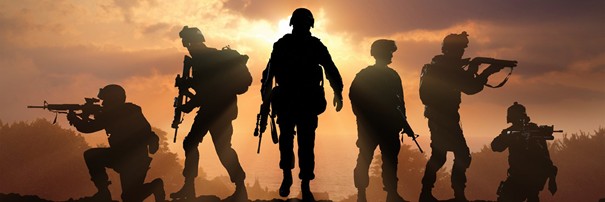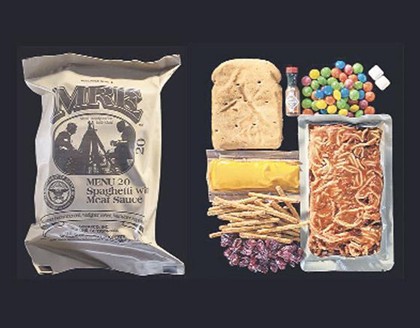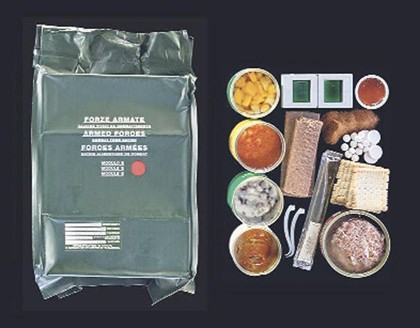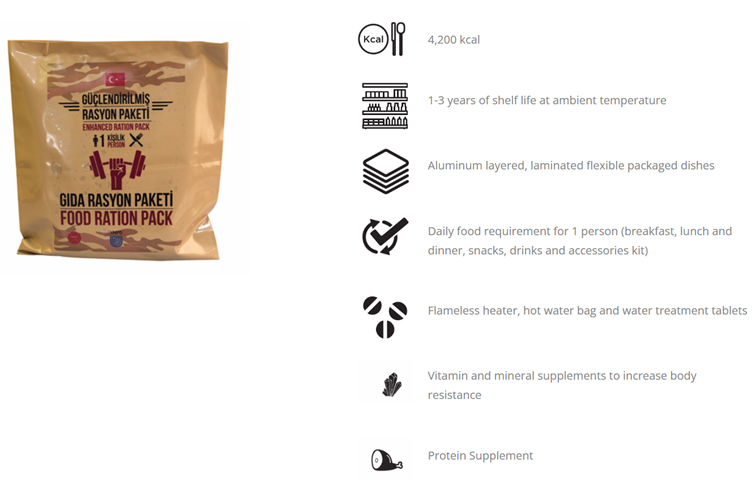
A field ration is a type of prepackaged military ration designed to be easily and quickly prepared and consumed in the field, in combat, at the front line, or where eating facilities are otherwise unavailable. Field rations are primarily used by military forces, though they are also sometimes distributed to civilians as part of humanitarian aid and emergency management. They differ from garrison rations and field kitchen provisions, which are intended for where proper meals can be supplied and prepared with relative ease and safety, such as in the rear where logistics are steady and fresh food can be supplied. They are similar to, but distinct from, other purpose-designed long-lasting types of food or rations such as emergency rations, humanitarian daily rations, and camping food.
Names used for field rations vary by military and type, and include combat ration, food packet, ration pack, battle ration, iron ration, or meal ready-to-eat (MRE); the latter is widely used but informal, and more accurately describes a specific U.S. field ration, the design and configuration of which has been used worldwide since its introduction. Field rations may be divided into two types: individual rations, which are intended to sustain a single soldier; and group rations, which are intended to sustain multiple soldiers in numbers ranging from a fireteam to a platoon.
Contents
 A typical field ration consists of:
A typical field ration consists of:
- An entrée or main course, typically full meals consisting of preserved and nonperishable precooked meat, vegetables, legumes, grains, rice, or staple foods; dehydrated soup or broth may also be offered, often in the form of bouillon cubes
- Side dishes or appetizers such as crackers or biscuits, spreads (commonly cheese spread, peanut butter, jam or jelly, chocolate spread, or pâté), pickles, or preservable salad (usually potato salad, tuna salad, or fruit salad)
- Desserts or snacks such as candy, chocolate, dried fruits, nuts, cookies, cakes, pastries, cereal bars, or energy bars
- Drink mixes, commonly juice, powdered milk, instant coffee, instant tea, hot chocolate, energy drinks, protein drinks, or soft drinks
- Food supplements such as condiments, chewing gum, dietary supplements, and water purification tablets
- Tableware, typically mess kits and eating utensils (usually a single multipurpose utensil like a spoon, spork, chopsticks, or lusikkahaarukka)
- Additional items provided for personnel to use for themselves, such as multipurpose paper, napkins or tissue paper, toilet paper, matches, cigarettes (historically), and solid fuel
Field rations may come in different varieties, or carry multiple meals, for breakfast, lunch, dinner, or supper. Vegetarian, vegan, and religious diet variants may be available if a military's demographics necessitate them. Specialized variants of field rations may exist for different environments, situations, and roles, such as cold-weather warfare, mountain warfare, jungle warfare, desert warfare, long-range reconnaissance patrols, and vehicle crew variants.
The meals offered in a field ration often come in multiple different "menus" (varieties) predominantly featuring foods from a military's national or traditional cuisine—and, if diverse enough and possible under the constraints of a field ration, fusion cuisine such as soul food or Canadian Chinese cuisine—intended to evoke the "taste of home" while on deployment or away. Some rations include commercially available items, often snacks such as Tootsie Rolls, Charms, and Yorkie bars. However, basic or less-accommodating rations (usually emergency rations) may consist of very simple meals intended to provide enough nutrients and energy to keep a soldier combat-ready or alive, like compressed food bars.
Field rations are commonly issued to land forces such as armies, who may spend lengthy periods of time away from fixed food sources. Navies and air forces are not commonly issued field rations as they are closely attached to the rear or steady supplies of food—prepared in galleys aboard naval vessels and flight kitchens at air bases—though they may still be issued to marines and air force ground forces. Additionally, rations may still be issued to personnel in certain situations or roles, like long-range flight rations for bomber, transport, and reconnaissance aircraft crews, who could otherwise spend hours in flight without food.
Packaging
 As field rations are intended to last long, the packaging they are stored in is designed to ensure a long shelf life and prevent spoilage. Rations are canned, vacuum-sealed, or freeze-dried foods stored in packages to prevent leakage or spoilage, commonly retort pouches, boxes, or cases. These containers are preferably easy to open, though some may require specific tools that are issued to soldiers or included in the ration package, such as the American P-38 can opener or Australian field ration eating device. Some, but not all, ration packages may be biodegradable or compostable.
As field rations are intended to last long, the packaging they are stored in is designed to ensure a long shelf life and prevent spoilage. Rations are canned, vacuum-sealed, or freeze-dried foods stored in packages to prevent leakage or spoilage, commonly retort pouches, boxes, or cases. These containers are preferably easy to open, though some may require specific tools that are issued to soldiers or included in the ration package, such as the American P-38 can opener or Australian field ration eating device. Some, but not all, ration packages may be biodegradable or compostable.
NATO categorizes ration packaging under three types:
- Primary packaging, which is in contact with or contains the food itself (e.g. a can containing food)
- Secondary packaging, which contains and groups several primary packages (e.g. a retort pouch containing food packages)
- Tertiary packaging, which contains and groups several secondary packages for storage, shipping, handling, and distribution (e.g. a box containing several rations for distribution)
Nutrition
NATO bases the nutritional content requirement on a reference soldier weighing 79 kg (174 lb), who on normal operations would have an energy expenditure of approximately 3,600 kcal per day. For combat operations, energy expenditure is estimated to be 4,900 kcal per day; however, this is seen to be a worst-case scenario.
